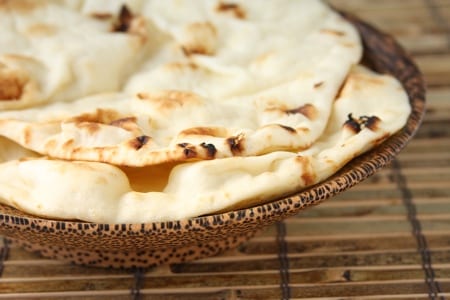 A lot of Indian food is naturally vegan, or at least can easily be made vegan, and for many it is up there alongside the tastiest cuisines in the world. Myriad spices and mountains of onions and garlic create tantalising sauces that just cry out to be mopped up with bread. Whilst the food of the sub-continent has a whole range of breads, for many, the naan is king. But is it a vegan king: is naan bread vegan?
A lot of Indian food is naturally vegan, or at least can easily be made vegan, and for many it is up there alongside the tastiest cuisines in the world. Myriad spices and mountains of onions and garlic create tantalising sauces that just cry out to be mopped up with bread. Whilst the food of the sub-continent has a whole range of breads, for many, the naan is king. But is it a vegan king: is naan bread vegan?
Our longer piece about bread in general looks at the main ingredients of this global staple to answer the question is bread vegan? We consider many different types of bread in that feature whilst we also answer the question many a hummus fan might ask: is pita bread vegan? But what about naan?
Is Naan Vegan?
Linking this Indian bread to our unscientific assumption about the average UK grandmother, sadly, we have to say that most naans – like most nans – are not vegan. A quick look at the ingredients of a packaged naan in the supermarket will often be disappointing because of the non-vegan ingredients that are often present.
As with many varieties of baked goods there is no fixed, definitive recipe for naan breads. As such, whether you get you naan from your favourite local restaurant or the 3am takeaway that you regret that next day, there is no simple, categorical answer as to whether or not your naans will be vegan. Equally, the same can be said about such India flatbreads bought from a supermarket, or even those handmade by you or a friend.
As with many foods and products looked at in the is it vegan? section of the site, there is no one all-encompassing answer. However, with naan breads, unlike many other items we have considered where the opposite applies, we feel it is safe to say that naans are not usually vegan.
Can You Make Vegan Naan Bread?
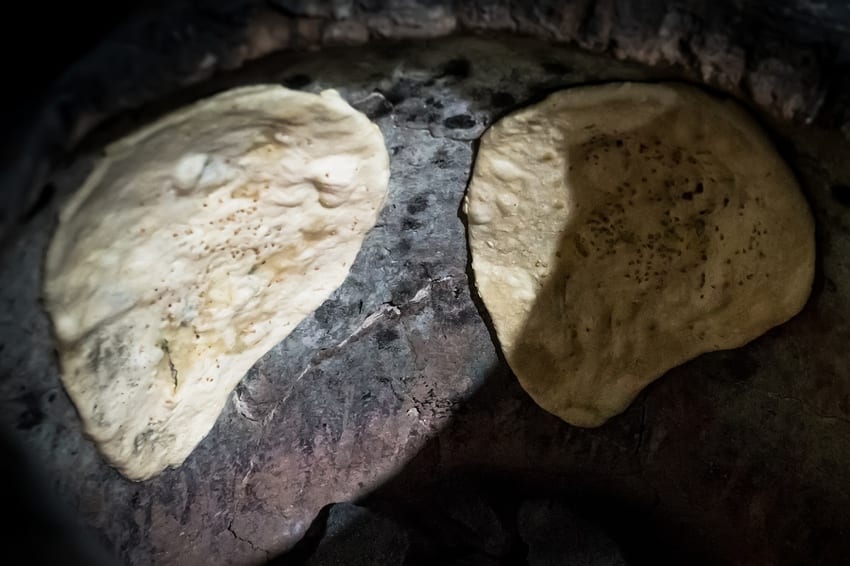
There are loads of recipes for vegan naan breads and, in fact, producing a vegan naan is not especially difficult. You can use yeast or baking powder to make your dough rise and produce a fluffy bread and use vegan butter substitutes to add richness, flavour and moisture. The former means there is no real need for milk, yoghurt or eggs, whilst the latter means you can leave out ghee or butter.
Ingredients in Naan
A vegan naan will usually be made from just flour, water, yeast and salt, perhaps with the addition of a vegan spread either in the recipe, or for serving, or sometimes both. Other recipes may add garlic, herbs, sugar or another vegan sweetening agent, baking powder or even a dairy free (usually coconut-based) yoghurt.
In truth, vegan naans are going to struggle to match the very best non-vegan naans when it comes to the perfect balance of fluffiness and chewiness. However, they get pretty damn close and we doubt very much that even your fussiest of friends would question them.
Brands of Vegan-Friendly Naan Bread
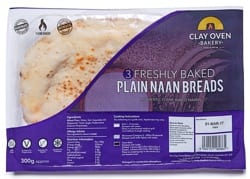
Most vegan naan bread recipes are very simple but if you want to buy readymade ones you do have some options too. Speciality health food and vegan-specialists shops sell them, as do online vegan retailers, such as TheVeganKind Supermarket.
Brands include Punjaban, who produce superb vegan naans, both plain and garlic and coriander, whilst Leicester’s Clay Oven Bakery have been going well over 10 years and all their products are vegan. These are now widely available too, in supermarkets including the Co-Op and Morrisons. They offer a range of naan breads and, once again, we very much doubt that even a naan expert would be able to tell they were vegan.
What Usually Makes Naan Bread Non-Vegan?
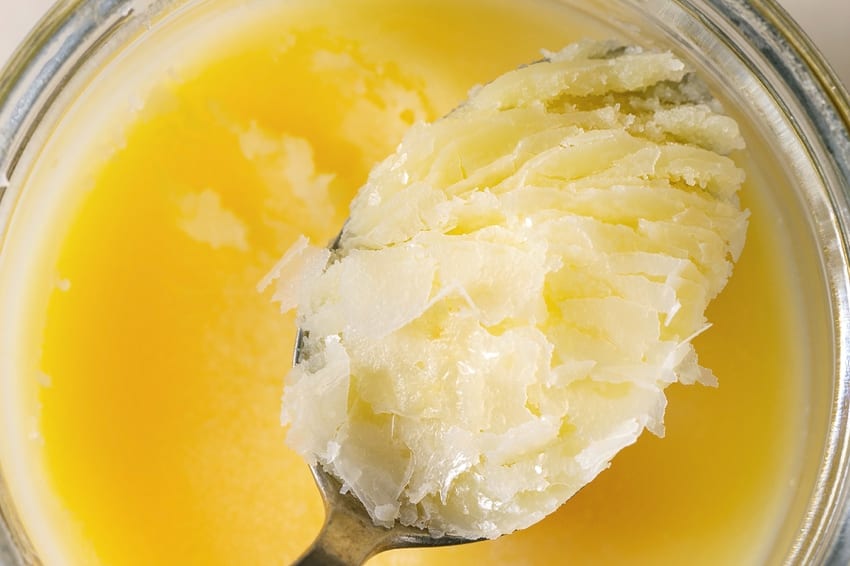
The reason that naans are less likely to be vegan than other breads, such as pita or a standard white loaf, is that there are a range of possible non-vegan inclusions. Naan bread may contain some or even all of these, as well as possible non-vegan additives on top in some processed products. The most likely ingredients to trouble naan-loving vegans are:
- Ghee
- Milk
- Yoghurt
- Eggs
Ghee or Butter
To Ghee or not to ghee? Ghee is clarified butter and, as with yoghurt, comes from dairy milk, and is, therefore, unsuitable for those following a plant-based diet. Ghee is a really common ingredient in dishes from all over India, as well as Pakistan, Bangladesh and other countries in the region. It is used in place of oil or other fat for frying and is also used to enrich sauces or as a finishing touch to some foods, including naan breads, to add shine, flavour or moisture. Its high smoke point also makes it ideal for deep frying.
In India, ghee is mainly made from the milk of cows or buffalo but, in theory, it could be made from the milk of almost any animal. When it comes to naan breads, the ghee may be used in both the main dough recipe to enrich it and also to brush on prior to serving. In this type of bread, butter or ghee can be used interchangeably. Just not by vegans, unfortunately.
Thankfully, whether it is butter or ghee that is used, this will always be clearly marked on the ingredients if you are buying a pre-made flatbread from your local shop or supermarket. In a restaurant or takeaway setting it is almost always safe to assume your naan bread will be made with butter or ghee unless you are eating in a vegan restaurant or have been told otherwise.
Milk, Yoghurt or Other Dairy
As we mention in our main feature, a number of breads feature milk, yoghurt or some other form of milk derivative and naan is certainly one of them. These are core ingredients of the dough in many naan bread recipes and, of course, render the end product non-vegan (aside from the butter or ghee that is probably also included!).
By using yoghurt or milk to replace some of the water in the dough, the finished naan bread is a little richer and also tends to be softer and fluffier. However, the real reason that yoghurt, in particular, was used to make naan bread was to leaven the dough. Many modern recipes use yeast to make the dough rise, or even baking powder, however, these were not part of traditional recipes.
Originally, the dough would have to be made using yoghurt as the sole leavening agent. It would have to be produced many hours in advance or even, in colder climates, the night before. The natural yeasts and bacteria in the yoghurt took longer to work and so a very long proving time was needed.
Whilst this is no longer strictly necessary many recipes still include yoghurt because it is traditional and, as said, because it produces a softer bread. In fact, some recipes go for a triple-leavening-agent approach and use yoghurt in addition to yeast and baking powder as well!
Once again, where such ingredients have been used in shop-bought naans, they will be clearly marked on the ingredients list. It is once again probably best to assume that any sort of decent restaurant has probably also opted for the traditional inclusion of yoghurt.
Eggs
Eggs are less commonly used in naan bread but we have certainly seen some recipes that use them. Few would consider them to be traditional, although bastion of modern British-Indian food, Madhur Jaffrey, does add a little egg to her dough, as do many other respected Indian food writers.
They are absolutely not necessary though and, in fact, in the opinion of some they result in a naan with a little too much texture that is almost tough. Rightly or wrongly though, the simple fact is that some naan breads, wherever you consume them, may contain eggs. Once again, this should be relatively clear from the label but, once again, in some ways this isn’t an issue as there are likely to be other non-vegan ingredients included anyway.
Keema, Cheese & Peshwari Naan
As well as various recipes being used, these fluffy Indian breads come in a variety of forms or flavours. On the subject of egg, we have even seen some naans that have whole eggs on or in them, but keema is a far more likely non-vegan naan varietal.
Keema is minced meat, usually lamb or beef, and a keema naan is one that almost all non-vegan/veggie restaurants will offer. Clearly this is not a naan bread for those eating only plants! Cheese is another naan varietal sometimes offered and, once again, this is obviously not something those on a vegan diet will want to order.
It is highly probable that a keema or cheesy naan will be non-vegan anyway but the fact that their filling or toppings are not vegan friendly means they can more easily and quickly be ruled out. Another type of bread you will routinely see offered in restaurants and takeaways is a Peshwari naan and, main ingredients aside, this is another that could pose issues for vegans.
This naan, actually from Peshawar in Pakistan originally, is quite sweet and is filled and/or topped with coconut, nuts and dried fruit. Some recipes, however, will also have a form of glaze and whilst this is sometimes made from sugar syrup, it may be made from honey, another vegan no-no.
Food Additives
All of the ingredients we have looked at thus far are “real” food and are at least to some extent traditional, natural and likely to be used by home cooks. Because they are core ingredients they are easy to spot and avoid but, as ever, there are a number of food additives that might find their way into naan breads that may be less obvious.
Such non-vegan preservatives, emulsifiers, stabilisers, flavourings and bulking agents are common in many products, including bread in general. That said, you are probably better off checking for the ingredients listed above first. If a baker has gone to the trouble of excluding eggs and dairy, they are probably aiming to create a vegan naan bread, in which case they won’t have used such non-vegan additives.
None the less, it pays to be aware of what might be used, especially as some of the dairy or egg inclusions might be listed in way not immediately obvious to everyone. If you see the following on the packet of your favourite naan bread, it is time to switch products!
- Lecithin – If the source is not listed, this may be non-vegan
- Whey – Any ingredients including this word will be dairy-derived
- Casein – Casein is another milk-based possible ingredient
- Xantham Gum – More likely to be included in gluten-free recipes, this is sometimes non-vegan
- Palm Oil – Not really an additive, and technically vegan, palm oil remains an ingredient many vegans might want to avoid for environmental reasons
Conclusion
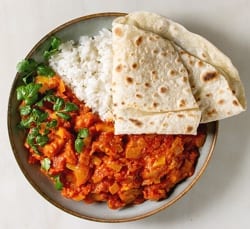 Unfortunately for naan fans, most breads of this type are not going to be suitable for vegans. There are numerous possible and probable additions that could make your favourite Indian flatbread non-vegan.
Unfortunately for naan fans, most breads of this type are not going to be suitable for vegans. There are numerous possible and probable additions that could make your favourite Indian flatbread non-vegan.
On the plus side, that means that you can be almost sure that naans are a no-no unless they are specifically sold as being vegan or you are in a vegan restaurant. That isn’t ideal if you’re a fan but at least makes things relatively simple.